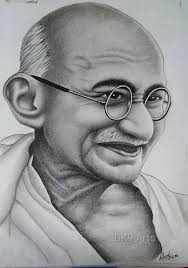MAHATMA GANDHI

Mahatma Gandhi: The Father of India and the Apostle of Non-Violence
Early Life and Birth (1869–1887)
Mohandas Karamchand Gandhi — later known as Mahatma Gandhi — was born on October 2, 1869, in Porbandar, a small coastal town in the present-day Gujarat, India. His father, Karamchand Gandhi, served as the Diwan (Chief Minister) of Porbandar, while his mother, Putlibai, was a deeply religious woman who influenced young Gandhi with her devotion, fasting, and belief in truth and compassion.
As a child, Gandhi was quiet and shy but showed an early sense of moral responsibility. He respected honesty and disliked injustice even in small matters. His early education took place in Rajkot, where he learned basic subjects and developed an interest in moral stories from Hindu scriptures like the Ramayana and Bhagavad Gita.
Journey to London and Legal Studies (1888–1891)
In 1888, at the age of 18, Gandhi sailed to London to study law at the Inner Temple. During his stay, he adapted to Western culture but remained true to his Indian roots. He explored world religions — Hinduism, Christianity, Islam, and Buddhism — which helped shape his spiritual and ethical beliefs. Gandhi completed his law degree in 1891 and returned to India to begin his legal career.
Struggles in South Africa (1893–1914)
In 1893, Gandhi accepted a one-year contract to work as a lawyer in Natal, South Africa. There, he faced severe racial discrimination — once being thrown out of a first-class train compartment despite having a valid ticket. This experience became a turning point in his life.
In response, Gandhi began organizing the Indian community in South Africa to fight injustice through nonviolent resistance, which he called Satyagraha (meaning “Truth Force”). For over 20 years, Gandhi led campaigns for civil rights, fought against racial segregation, and inspired thousands to protest peacefully. His efforts led to significant reforms and made him a global symbol of justice and equality.
Return to India and Freedom Struggle (1915–1947)
Gandhi returned to India in 1915, invited by Gopal Krishna Gokhale, a senior Indian leader. He traveled across the country to understand the condition of the poor and farmers. Soon, he became a leading figure in India’s independence movement under the Indian National Congress.
Champaran and Kheda Movements
His first major success came in Champaran (1917), where he helped indigo farmers oppressed by British planters. In Kheda (1918), he supported farmers demanding tax relief during famine. Both movements established Gandhi’s power as a leader of the masses.
Non-Cooperation Movement (1920–1922)
After the Jallianwala Bagh massacre (1919), Gandhi launched the Non-Cooperation Movement, urging Indians to boycott British goods, schools, and institutions. Millions joined, turning it into a nationwide protest. However, Gandhi suspended the movement after the Chauri Chaura incident when protestors turned violent — reinforcing his strict belief in nonviolence (Ahimsa).
Salt March and Civil Disobedience (1930)
In 1930, Gandhi led the legendary Dandi March, walking 240 miles to make salt from the sea in defiance of British salt taxes. This act became a global symbol of peaceful resistance and inspired other nations fighting colonial rule.
Quit India Movement (1942)
During World War II, Gandhi launched the Quit India Movement demanding immediate British withdrawal. He famously said, “Do or Die.” The British arrested him and many other leaders, but the movement ignited a national spirit of defiance.
Philosophy and Legacy
Gandhi’s philosophy centered on Truth (Satya), Nonviolence (Ahimsa), and Self-Rule (Swaraj). He promoted simple living, hand-spinning (Khadi), and rural self-sufficiency. His ideas influenced world leaders like Martin Luther King Jr., Nelson Mandela, and the Dalai Lama. Gandhi believed that real freedom came not only from political independence but from moral and spiritual awakening.
Independence and Tragic Death (1947–1948)
On August 15, 1947, India finally gained independence after nearly 200 years of British rule. However, Gandhi was deeply saddened by the partition of India and Pakistan, which led to communal violence and loss of life.
He devoted his final months to promoting peace and unity between Hindus and Muslims. On January 30, 1948, Gandhi was assassinated in New Delhi by Nathuram Godse, a Hindu extremist, while on his way to a prayer meeting. His last words were “Hey Ram,” reflecting his lifelong devotion to truth and faith.
Mahatma Gandhi’s Enduring Influence
Even after his death, Gandhi’s teachings continue to shape the world. His birthday, October 2, is celebrated globally as the International Day of Non-Violence. Gandhi remains a timeless symbol of peace, justice, humility, and humanity — a leader who changed the course of history without ever raising a weapon.
🔑 SEO Keywords:
Mahatma Gandhi biography, Gandhi life story, Indian freedom fighter, Father of the Nation, Gandhi nonviolence, Satyagraha, Gandhi assassination, Dandi March, Indian independence history, Gandhi philosophy.
